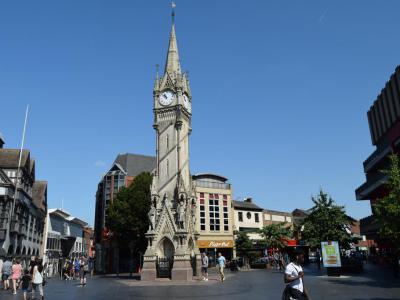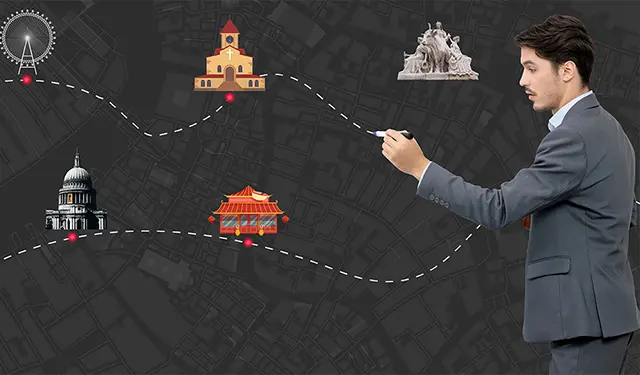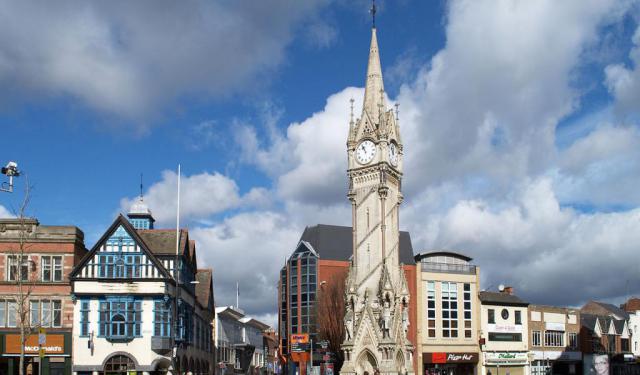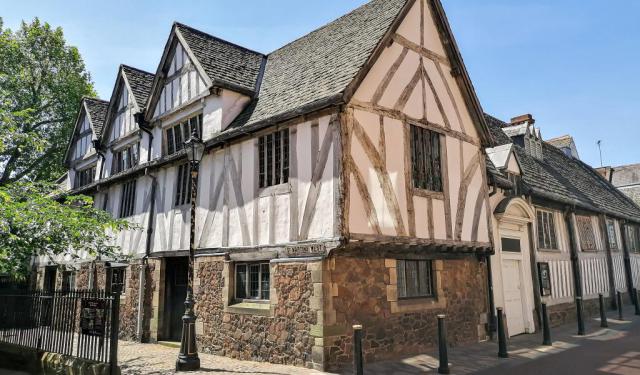
Haymarket Memorial Clock Tower, Leicester
The Haymarket Memorial Clock Tower is one of Leicester’s most recognizable landmarks and a favored meeting spot. Positioned near the city center within the ring road, it marks the convergence of five key streets: Gallowtree Gate, Humberstone Gate, Belgrave Gate, Church Gate, and Eastgates, with Cheapside also nearby. For generations, it has been the go-to rendezvous point in the heart of the city.
Before the Clock Tower’s construction, the site housed an Assembly Room built in 1750, later repurposed into shops in 1805. Over time, it gained a reputation as "the Haymarket Obstruction," prompting local property owners to campaign for its removal. The building was demolished in 1862, though the hay market remained in place until it was eventually moved to Humberstone Gate.
Clearing the site left a broad open space that became increasingly difficult for pedestrians to navigate due to heavy traffic. Meanwhile, plans for an illuminated clock at the London Road and Belvoir Street junction sparked local businesses to petition for a striking alternative: a grand clock with lamps and a statue of Sir Thomas White, a well-known local benefactor.
Completed in 1868, the Clock Tower was built primarily from Ketton stone, with a Mountsorrel granite base. It features polished Peterhead granite and serpentine columns, while its statues were sculpted from Portland stone. Notably, the tower was erected above the intersection of two major city sewers, which had to be modified before construction could begin.
As a memorial, the Clock Tower honors four notable figures from Leicester’s history, each represented by a statue at its corners: Simon de Montfort, William Wyggeston (spelled 'Wigston' on the tower), Thomas White, and Gabriel Newton.
Before the Clock Tower’s construction, the site housed an Assembly Room built in 1750, later repurposed into shops in 1805. Over time, it gained a reputation as "the Haymarket Obstruction," prompting local property owners to campaign for its removal. The building was demolished in 1862, though the hay market remained in place until it was eventually moved to Humberstone Gate.
Clearing the site left a broad open space that became increasingly difficult for pedestrians to navigate due to heavy traffic. Meanwhile, plans for an illuminated clock at the London Road and Belvoir Street junction sparked local businesses to petition for a striking alternative: a grand clock with lamps and a statue of Sir Thomas White, a well-known local benefactor.
Completed in 1868, the Clock Tower was built primarily from Ketton stone, with a Mountsorrel granite base. It features polished Peterhead granite and serpentine columns, while its statues were sculpted from Portland stone. Notably, the tower was erected above the intersection of two major city sewers, which had to be modified before construction could begin.
As a memorial, the Clock Tower honors four notable figures from Leicester’s history, each represented by a statue at its corners: Simon de Montfort, William Wyggeston (spelled 'Wigston' on the tower), Thomas White, and Gabriel Newton.
Want to visit this sight? Check out these Self-Guided Walking Tours in Leicester. Alternatively, you can download the mobile app "GPSmyCity: Walks in 1K+ Cities" from Apple App Store or Google Play Store. The app turns your mobile device to a personal tour guide and it works offline, so no data plan is needed when traveling abroad.
Haymarket Memorial Clock Tower on Map
Sight Name: Haymarket Memorial Clock Tower
Sight Location: Leicester, England (See walking tours in Leicester)
Sight Type: Attraction/Landmark
Guide(s) Containing This Sight:
Sight Location: Leicester, England (See walking tours in Leicester)
Sight Type: Attraction/Landmark
Guide(s) Containing This Sight:
Walking Tours in Leicester, England
Create Your Own Walk in Leicester
Creating your own self-guided walk in Leicester is easy and fun. Choose the city attractions that you want to see and a walk route map will be created just for you. You can even set your hotel as the start point of the walk.
Leicester Introduction Walking Tour
Leicester is one of the oldest cities in England, whose history goes back almost two millennia. The Romans arrived in the area around 47 AD, during their conquest of southern Britain. Following the Saxon invasion, Leicester was then captured by Danish Vikings, in the 9th century.
The settlement was first documented in the early 10th century, under the name Ligeraceaster. At the time of the... view more
Tour Duration: 1 Hour(s)
Travel Distance: 1.1 Km or 0.7 Miles
The settlement was first documented in the early 10th century, under the name Ligeraceaster. At the time of the... view more
Tour Duration: 1 Hour(s)
Travel Distance: 1.1 Km or 0.7 Miles
Historical Buildings
Leicester, a city in England's East Midlands, has a storied past that is vividly presented in its historical buildings. Valuable architectural monuments, they are the city's pride and as such enjoy special protection by the government.
Among such, Magazine Gateway stands as a testament to the city's medieval legacy. Originally part of its defensive walls, this structure now... view more
Tour Duration: 2 Hour(s)
Travel Distance: 2.6 Km or 1.6 Miles
Among such, Magazine Gateway stands as a testament to the city's medieval legacy. Originally part of its defensive walls, this structure now... view more
Tour Duration: 2 Hour(s)
Travel Distance: 2.6 Km or 1.6 Miles


